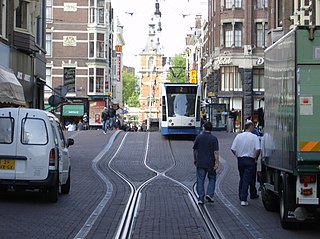Related Research Articles
Road speed limits are used in most countries to set the legal maximum or minimum speed at which road vehicles may travel on a given stretch of road. Speed limits are generally indicated on a traffic sign reflecting the maximum or minimum permitted expressed as kilometres per hour (km/h) and/or miles per hour (mph). Speed limits are commonly set by the legislative bodies of national or provincial governments and enforced by national or regional police and judicial authorities. Speed limits may also be variable, or in some places unlimited, such as on most of the Autobahn in Germany.

An intelligent transportation system (ITS) is an advanced application which aims to provide innovative services relating to different modes of transport and traffic management and enable users to be better informed and make safer, more coordinated, and 'smarter' use of transport networks.
Traffic psychology is a discipline of psychology that studies the relationship between psychological processes and the behavior of road users. In general, traffic psychology aims to apply theoretical aspects of psychology in order to improve traffic mobility by helping to develop and apply crash countermeasures, as well as by guiding desired behaviors through education and the motivation of road users.
The Environmental Transport Association (ETA) is a British carbon-neutral provider of vehicle breakdown, bicycle and travel insurance for the environmentally concerned consumer. Unlike the AA or the RAC which are perceived as pro-car, the ETA aims to raise awareness of the impact that transport has on the environment and help individuals and organisations to make positive changes in their travel habits. They offer breakdown and road rescue for cyclists and mobility scooter users as well as motorists.

Sustainable transport refers to the broad subject of transport that is sustainable in the senses of social, environmental and climate impacts. Components for evaluating sustainability include the particular vehicles used for road, water or air transport; the source of energy; and the infrastructure used to accommodate the transport. Transport operations and logistics as well as transit-oriented development are also involved in evaluation. Transportation sustainability is largely being measured by transportation system effectiveness and efficiency as well as the environmental and climate impacts of the system.

The Erasmus Programme is a European Union (EU) student exchange programme established in 1987. Erasmus+, or Erasmus Plus, is the new programme combining all the EU's current schemes for education, training, youth and sport, which was started in January 2014.

The Directorate-General for Mobility and Transport is a Directorate-General of the European Commission responsible for transport within the European Union.
The RAC Foundation is a registered charity.

Speed limits in the United States are set by each state or territory. States have also allowed counties and municipalities to enact typically lower limits. Highway speed limits can range from an urban low of 20 mph (32 km/h) to a rural high of 85 mph (137 km/h). Speed limits are typically posted in increments of five miles per hour (8 km/h). Some states have lower limits for trucks and at night, and occasionally there are minimum speed limits.

The International Association of Public Transport is a non-profit advocacy organization for public transport authorities and operators, policy decision-makers, scientific institutes and the public transport supply and service industry. The association was founded on August 17, 1885 by King Leopold II in Brussels, Belgium to support the Belgian tram and steel industries. UITP supports a holistic approach to urban mobility and advocates for public transport development and sustainable mobility.

A motorized scooter is a powered stand-up scooter using a small utility internal combustion engine or, more commonly, an electric motor. Classified as a form of micro-mobility, these scooters are generally designed with a large deck in the center on which the rider stands. The first production scooter, the "Sport", was released by Go-Ped in 1985.
Hypermobile travelers are "highly mobile individuals" who take "frequent trips, often over great distances." They "account for a large share of the overall kilometres travelled, especially by air." These people contribute significantly to the overall amount of airmiles flown within a given society. Although concerns over hypermobility apply to several modes of transport, the environmental impact of aviation and especially its greenhouse gas emissions have brought particular focus on flying. Among the reasons for this focus is that these emissions, because they are made at high altitude, have a climate impact that is commonly estimated to be 2.7 higher than the same emissions if made at ground-level.

An advisory speed limit is a speed recommendation by a governing body, used when it may be non-obvious to the driver that the safe speed is below the legal speed. It is a posting which either approximates the Basic Speed Law or rule or is based on a maximum g-force exerted at a specific speed. Advisory speed limits are often set in areas with many pedestrians, such as in city centers and outside schools, and on difficult stretches of roads, such as on tight corners or through roadworks. While travelling above the advisory speed limit is not illegal per se, it may be negligence per se and liability for any collisions that occur as a result of traveling above the limit can be placed partially or entirely on the person exceeding the advisory speed limit.
Intelligent speed adaptation (ISA), also known as alerting, and intelligent authority, is any system that ensures that vehicle speed does not exceed a safe or legally enforced speed. In case of potential speeding, a human driver can be alerted, or the speed reduced automatically.
Siemens Mobility, also known as Siemens Transportation Systems is a separately-managed company of Siemens AG, arising from a corporate restructuring effective 1 August 2018. With its global headquarters Munich, Siemens Mobility has four core business units: Mobility Management, dedicated to rail technology and intelligent traffic systems, Railway Electrification, Rolling Stock, and Customer Services.
Vision Zero is a multi-national road traffic safety project that aims to achieve a highway system with no fatalities or serious injuries involving road traffic. It started in Sweden and was approved by their parliament in October 1997. A core principle of the vision is that 'Life and health can never be exchanged for other benefits within the society' rather than the more conventional comparison between costs and benefits, where a monetary value is placed on life and health, and then that value is used to decide how much money to spend on a road network towards the benefit of decreasing how much risk.

Active mobility, active travel, active transport or active transportation, is a form of transport of people and sometimes goods, that only uses the physical activity of the human being for the locomotion. The most well-known forms of active mobility are walking and cycling, though other mobility means such as running, skateboard, kick scooter and roller skates are also forms of active mobility. In certain latitudes and elevations, practical transportation may also include cross-country skiing and snowshoeing, perhaps only in the winter season.
Transport Research Arena (TRA) is a conference on transport and mobility in Europe. It was initiated in 2006 and takes place every two years in a different European city. TRA is co-organised by the European Commission and supported by the European Technology Platforms ERTRAC, ERRAC, WATERBORNE as well as CEDR and ALICE, ETRA and ECTP.

The Juncker Commission was the European Commission in office since 1 November 2014 to 30 November 2019. Its president was Jean-Claude Juncker, who presided over 27 other commissioners. In July 2014, Juncker was officially elected to succeed José Manuel Barroso, who completed his second five-year term in that year.
The Tortona–Genoa high-speed railway, also known as Third Pass, will be a railway designed for high-speed, high-capacity services linking Genoa to Tortona near Milan, Italy. Works started in 2013 and the railway is expected to be completed by 2022. The line will be 53 kilometres (33 mi) long, 36 kilometres (22 mi) of which being tunnels. Further 25 kilometres (16 mi) of branches connecting the railway to existing lines are also planned. The estimated cost for the construction of the railway is 6.2 billion euros.
References
- ↑ Lamm, R., Choueiri, E.M. (1987). Rural Roads Speed Inconsistencies Design Methods, Research Report for the State University of New York. Research Foundation, Parts I and II, Albany, N.Y., U.S.A,;1; 1987.
- ↑ Anonymous (2016-10-17). "Current speed limit policies - Mobility and transport - European Commission". Mobility and transport - European Commission. Retrieved 2018-11-29.
| This law-related article is a stub. You can help Wikipedia by expanding it. |